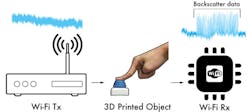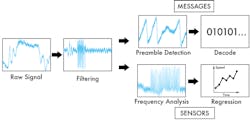Using Conductive Printed 3D Plastic Parts to Sense Motion
IoT and other sensor-based applications have a constraint: how to connect the switches and other motion-based sensors to a local Wi-Fi network. Running even a small switch-closure wire between a transducer source point and a local wireless node is often a physical nuisance, especially if that point is on a moving object such as a door or a bottle.
To address this problem, a team at the University of Washington claims to be the first to devise a way to print 3D (additive manufacturing) objects which function as sensors using plastic with embedded conductive threads, and then connect these wirelessly to the local 2.4 GHz Wi-Fi node. The technique uses RF backscatter so the Wi-Fi system sees the change in physical appearance or location of the sensed object (they call them “widgets”). The result is a low-cost, wireless, zero-power transducer/Wi-Fi link (Fig. 1).
1. The zero-power switch interface uses the changes in Wi-Fi RF backscatter which occurs with small-scale motion of plastic, 3D-printed objects having embedded, conductive filaments. (Source: University of Washington)
The researchers’ detailed-yet-highly-readable paper, “3D Printing Wireless Connected Objects,” published in ACM Transactions on Graphics, explains the concept, shows the many test widgets they built, and details range of tests they conducted. The team demonstrated that its approach allows for the detection of simple actions such as a mechanical on/off switch being activated.
Furthermore, the magnetic properties of the ferromagnetic plastic material can also be used to encode up to 12 bits in a short stream of encoded in the widget, which could be sensed and decoded using a smartphone-based maglink receiver. Data rates were on the order of 10 bits/sec (slow, but sufficient for the application) over distances in the tens of cm range (again, adequate for many IoT applications).
Key to the detection technique is use of backscatter, the pattern that a receiver sees due to conductive objects in an RF field. When an object moves or changes shape, the backscatter signal is affected, and this change can be detected and demodulated. (Backscatter is somewhat like radar, which relies on an intentional transmit pulse and received echo.) To make the team’s technique work well, each 3D printed widget incorporates a reflecting antenna (dipole or bowtie) to enhance the distinctions in the backscatter signal among its positions.
For example, the team built several very different versions of a basic on/off switch. In one design, the switch replicates the action of a pushbutton using a cantilever separating spring element (Fig. 2). It uses a planar spring built as a 1 mm thick spiral structure, with the outer edges of the spiral fixed to a rectangular case, and increased the contact area of the switch by 100× to improve the difference in backscatter radar cross section. The integral bowtie antenna has a relatively wide beam width and greater bandwidth than a dipole, thus making it more resilient to fabrication error.
2. This simple on/off switch incorporates a bowtie antenna to enhance RF reflectivity, and so affects the backscatter signal, shown in a) pressed and b) unpressed states. (Source: University of Washington)
The team’s concept is not limited to simple on/off switches: It also used a printed gear-tooth assembly to implement a flowmeter (Fig. 3), which it then attached to a standard liquid-detergent bottle via a printed fitting. As the detergent was poured out, the gear rotated and thus signaled—again via on-off transitions—the volume of liquid flow and use.
3. The concept has been expanded to a flowmeter transducer with a simple gear, which causes backscatter pulsing as the fluid flow rotates the gear. (Source: University of Washington)
The complementary challenge to designing and fabricating useful 3D printed objects which affect backscatter due to position is the reception, demodulation, and signal processing of these backscatter signals. Here, the backscatter signal is a narrowband transmission embedded on top of the ambient Wi-Fi signals (Fig. 4).
4. Capturing, demodulating, and decoding the backscatter is a signal-processing challenge, given the generally low SNR and other impediments, but the idea has been successfully demonstrated over limited distances, and in spite of the reflecting object’s motion. (Source: University of Washington)
Adding to the difficulties are the ever-present noise, adjacent signals, marginal SNR, and even movement of the widget itself with respect to the Wi-Fi system (the object being sensed could be part of a mobile product, such as that detergent bottle). To overcome the basic reception and decoding issues, the team used a variety of data encoding and signal-processing techniques discussed in the paper, along with graphs of test results and various perspectives.
Whether is this a viable approach in the real world is obviously an open issue, but it is an interesting demonstration, yet again, of how highly disparate technologies can combine to offer a new approach to an old problem. Here, Wi-Fi, backscatter, signal processing, and complex 3D printing use conductive plastic objects to offer an approach to providing wireless, zero-power connectivity between a transducer and associated node.
About the Author

Bill Schweber
Contributing Editor
Bill Schweber is an electronics engineer who has written three textbooks on electronic communications systems, as well as hundreds of technical articles, opinion columns, and product features. In past roles, he worked as a technical website manager for multiple topic-specific sites for EE Times, as well as both the Executive Editor and Analog Editor at EDN.
At Analog Devices Inc., Bill was in marketing communications (public relations). As a result, he has been on both sides of the technical PR function, presenting company products, stories, and messages to the media and also as the recipient of these.
Prior to the MarCom role at Analog, Bill was associate editor of their respected technical journal and worked in their product marketing and applications engineering groups. Before those roles, he was at Instron Corp., doing hands-on analog- and power-circuit design and systems integration for materials-testing machine controls.
Bill has an MSEE (Univ. of Mass) and BSEE (Columbia Univ.), is a Registered Professional Engineer, and holds an Advanced Class amateur radio license. He has also planned, written, and presented online courses on a variety of engineering topics, including MOSFET basics, ADC selection, and driving LEDs.





